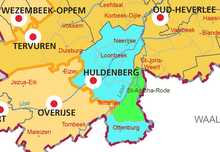Sint-Agatha-Rode | |
|---|---|
 | |
| Coordinates: 50°47.2′N04°38′E / 50.7867°N 4.633°E | |
| Country | Belgium |
| Region | Flemish Region |
| Community | Flemish Community |
| Province | Flemish Brabant |
| Municipality | Huldenberg |
| Area | |
• Total | 7.23 km2 (2.79 sq mi) |
| Population (1 January 2006) [1] | |
• Total | 1,532 |
| • Density | 210/km2 (550/sq mi) |
| Postal codes | 3040 |
| Area codes | 016 |
| Website | www.huldenberg.be |
Sint-Agatha-Rode, named after the third-century Christian martyr Saint Agatha of Sicily, [2] is a Dutch-speaking village in Belgian province of Flemish Brabant and lies within the district of the town of Huldenberg. [a] Historically Sint-Agatha-Rode was an independent municipality (Gemeente) until the merger of Belgian municipalities in 1977 when it was joined to the town of Huldenberg.
Contents
Sint-Agatha-Rode is located east of the town centre of Huldenberg, in the hills between the valleys of the river Dijle which is the eastern boundary of the Huldenberg district and the river Laan which is the western boundary. North of the town center of Sint Agatha-Rode the Laan joins the Dyle. The eastern boundary of the village is the language barrier with the Walloon villages of Nethen and Pecrot and to the south is the Flemish village of Ottenburg. Sint-Agatha-Rode has developed from being an agricultural village to become a rural residential town.








